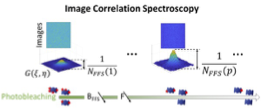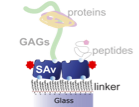Molecular quantification of density and oligomerization
Counting and characterizing molecules in their biological environment is an important challenge for our fundamental understanding of life but also for clinical prospects (regenerative medicine, etc.).
Counting and characterizing molecules in their biological environment, whether it is in cells, extra-cellular matrix or biomimetic systems, is an important challenge for our fundamental understanding of life but also for clinical prospects (regenerative medicine, etc.). Beside pure observation, quantification thus aims at providing reliable numbers, e.g. the number of molecules that are present in some given region of space, at some time. For in vitro cellular studies, well-established methods can be applied ex situ on a model support that differs from the surface where cells will be plated (substrate). There is therefore a demand for robust techniques working in situ to characterize the substrate just before cellular seeding.
Fluorescence Fluctuation Spectroscopy (FFS) is a family of techniques that takes benefit from the properties of statistical fluctuations. Thanks to the collaboration between LIPhy and CEA, BRM team, we were able to develop well controlled substrates for cellular studies and, by combining FFS with photobleaching, to provide reliable estimation of the number of molecules. In particular we developed a streptavidin (SAv) based platform on top of which different biotinylated molecules can be grafted. The SAv monolayer has been characterized with FFS but the remaining biotinylated molecules have not been quantified.
We now want to make a step further by addressing more complex biomaterials for cellular studies where knowing the amount of molecule is fundamental. The same technique (called pbFFS for photobleaching Fluctuation Fluorescence Spectroscopy) can also be applied to oligomerization, clustering or aggregation, which mediate a myriad of biochemical processes. For example, in cellular signalling, the same molecule can modulate its affinity to its partners and activate different cellular response depending on whether it is in monomeric or oligomeric states.
Webpage:
https://www-liphy.univ-grenoble-alpes.fr/Molecular-quantification-of-1503
References:
-
Combining fluorescence fluctuations and photobleaching to quantify surface density
J. Sefkow-Werner, E.Migliorini, C. Picart, D. Wahyuni, I. Wang and A. Delon
Analytical Chemistry (submitted) http://arxiv.org/abs/2110.14319
-
Practical guide to characterize biomolecule adsorption on solid surfaces (Review)
E. Migliorini, M. Weidenhaupt, C. Picart
Biointerphases 2018, 13, 06D303 https://doi.org/10.1116/1.5045122
Program, or background and skills expected: Master program in
Soft Nanosciences -
Nanochemistry - or
Phelma Biomedical Engineering
Expected skills: basics of fluorescence microscopy, be comfortable with image and data analysis, modeling.
We are looking for a student with a background in physics and willing to work in a multi-disciplinary environment involving optics, chemistry and biology.
Published on September 30, 2021
Updated on September 19, 2023

